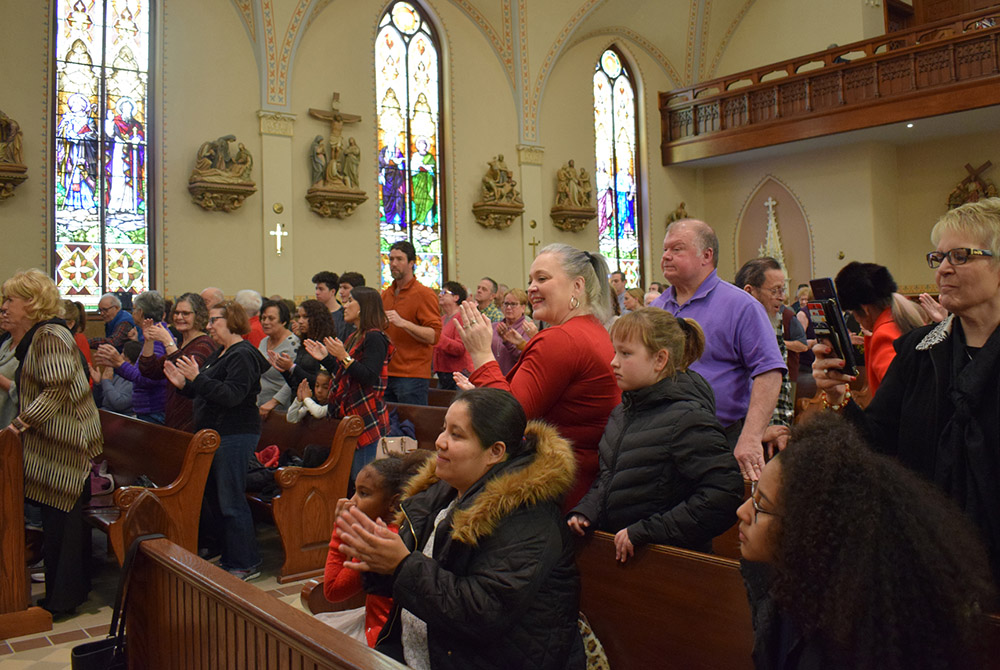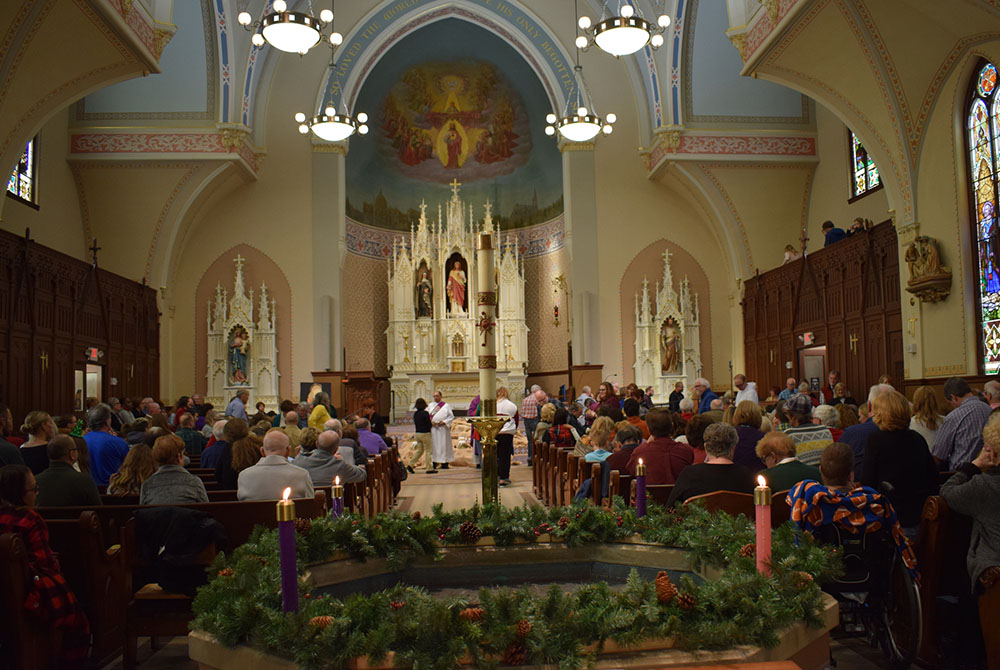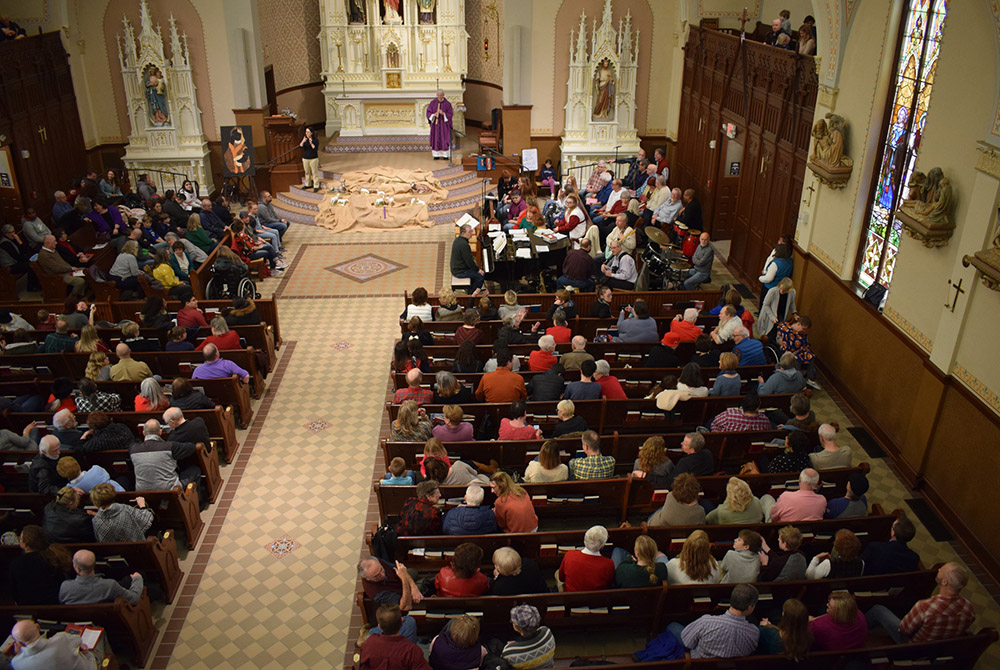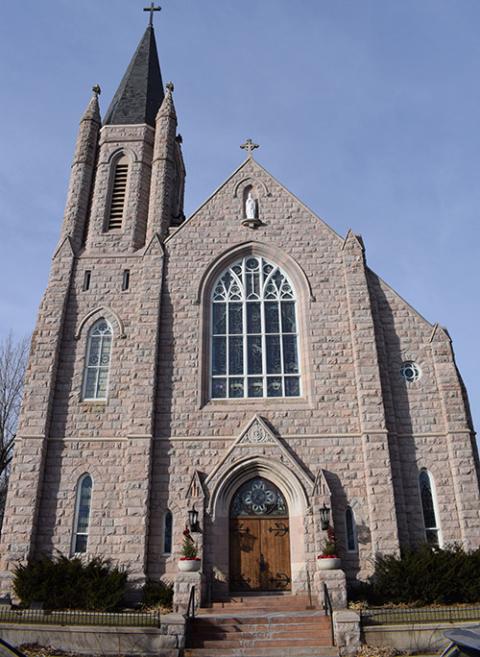
The congregation claps along during a song by the Freedom Choir Dec. 22, 2019, at Sacred Heart Church in Omaha, Nebraska. The coronavirus has since impacted life at Sacred Heart. The church is now open for weekend Mass, but, because of social distancing requirements, only 37 families can be allowed into the church at any one time. The Mass remains available via livestreaming. (Elizabeth A. Elliott)
At the Our Father, they joined hands across the aisle, trying to bring the all-encompassing kingdom to this North Omaha community. Now, after the pandemic, that contact has been curtailed. But its spirit lives on.
When asked what draws parishioners to Sacred Heart Church, the term inclusion seemed to be a frequent reason.
"You can go through this church and almost everyone in the church is healing from some kind of brokenness and that brokenness is what drew them here," said parishioner Mickey Kotlarz. "It's not just one thing — the choir, the pastor — everything together is what brings us all together. We are inclusive. There are people with challenges, divorced, single, those who feel outcast. They are welcome here."
Mary Ann Nipp has been a parishioner for more than 20 years. "The love and acceptance of everyone [draws me here]. Everyone is welcome," she said. "It doesn't make any difference who you are, where you've been or what you've done. The warmth of the community reflects the love of God."

Sacred Heart Church is full for the fourth Sunday of Advent, Dec. 22, 2019, in Omaha. (Elizabeth A. Elliott)
People would drive from every neighborhood and even surrounding cities to attend Mass.
Parishioner Todd Perry drove around 30 minutes from Plattsmouth, Nebraska, each weekend.
"I [come because of] the life that's in this parish and variety of people that come from all walks of life," he said. "The drive is worth it."
As the neighborhood demographics changed in the North Omaha area, Sacred Heart moved from an Irish Catholic parish to one that served more universal needs.
The community of Sacred Heart Church reaches beyond the steeple in several ways. The Heart Ministry Center, an outreach ministry, began as the Sacred Heart Human Needs Door Ministry in 1982. It provided food, clothing and basic needs for neighbors and families of children enrolled in Sacred Heart School, according to its website. The Heart Ministry Center became a nonprofit organization in 2007. It expanded in 2010 to include health care services, group mentoring program for at-risk youth, free legal services, a dental clinic, social work and case management services.

Pastor Dave Korth leads an Advent meditation with his Native American flute Dec. 22, 2019, at Sacred Heart Church in Omaha, Nebraska. (Elizabeth A. Elliott)
The parish also began a program called the Fresh Start job placement program, a three-month class that teaches employability. Partnerships with employers provide the opportunity to be hired for a job as they graduate from the program, up to 7,000 people per month.
Fr. Dave Korth, pastor, said the Heart Ministry Center is the largest food pantry in the state of Nebraska.
"Giving birth to the Heart Ministry Center is a huge success story of the parish," said Korth. "It's also been helpful that we handed it off. Part of our success is we don't hold on to, but have given birth to, and allow these things to grow and thrive on their own."
Another program developed at Sacred Heart is CUES — Christian Urban Education Services. CUES began in 1975 to keep Sacred Heart School open at a time when the parish couldn't keep paying for the school. The neighborhood was changing by the 1960s. The school is 78% African American, 10% African, 8% multicultural, 3% Latino and 1% Asian. Ninety-six percent of students qualify for federal free or reduced lunch.
The program expanded in 2012 to reach two other inner-city schools. According to its website, In 2018 CUES became two separate organizations — CUES School System and the CUES Fund.
Korth said the school represents the neighborhood with 92% of the children not being Catholic.
"I tell donors we are educating them because we are Catholics," he said. "As Catholics we are called to be with the poorest of the poor."
Korth said the challenge is to transform the people who come here for the weekends to not come only for great music and a warm welcome.
"They also need to see that we still want to be this rock in this neighborhood," he said. "We want to be a part of doing what we can to bring the Gospel to this area of town in how we reach out through social justice and try to make a difference in the area."

The congregation fills the pews Dec. 22, 2019, at Sacred Heart Church in Omaha. (Elizabeth A. Elliott)
Korth said the parish has a concerted effort to be better neighbors, especially with the color in the church not matching the racial makeup of the neighborhood.
"We did outreach but I said they need to have more of an effort of doing it ourselves rather than just handing over a check to the Heart Ministry," he said.
A Summer Festival, held virtually this year because of the pandemic, is one way the parish reaches out to the neighborhood.
"We go door-to-door to invite the neighbors to the festival," said Korth. "It changed from a big party for us to a neighborhood event."
The parish is trying to be a more active partner in the neighborhood, paying dues to a union for contemporary art, joining neighborhood associations and joining in advertising in The Omaha Star newspaper, Nebraska's only Black bi-weekly newspaper.

Sacred Heart Church sits in the neighborhood of 22nd and Binney Streets. (Elizabeth A. Elliott)
The parish began as an Irish Catholic parish, where statues of St. Bridget and St. Patrick can be found on either side of Christ on the altar. And though the parish is welcoming to all peoples, it did have a history of racism.
People of color moved into the area from 1950 to 1960. Many of the white homeowners were Sacred Heart parishioners, but they moved west, starting over in newly white neighborhoods and all new white churches. It left Sacred Heart hurting for parishioners.
In 2018, Sacred Heart Church held a ceremony for healing and reconciliation regarding the parish's history with St. Benedict the Moor Parish in Omaha, the designated parish for Black Catholics. Black Catholics who attended Sacred Heart were asked not to return when St. Benedict the Moor was established.
"St. Benedict the Moor started because they were turned away at Sacred Heart," said Korth. "We put together the prayer service to pray for the past hurts of our parish. We have to own it as part of our history. It's not who we are now, so if we want to move forward, we need to know about it so we don't repeat it. We are owning that this was a horrible part of our past."
More than 20 years ago, Sacred Heart was a founding member of the organization Omaha Together One Community, or OTOC. OTOC holds elected officials accountable, engages in public discourse and teaches people to become effective leaders.
The coronavirus has impacted life at Sacred Heart. The parish has found its reach going beyond the boundaries of the North Omaha neighborhood and across the world through the web.
Korth said the numbers the parish is reaching are remarkable. One of their videos went viral.
"We noticed right after that that people started watching the weekend Mass way more," he said. "We've been getting people contacting us saying, 'I stepped away from the Catholic Church years ago and you guys are filling a void.' It's messages like that, or, 'My kids left the church years ago and I know they're watching you now.' "
Korth said he is looking at next steps.
Advertisement
"Obviously, views are nice, but you don't run a parish that way; you don't help people go deeper in their relationship with Jesus simply being a link," he said. "We have people in China watching, it's completely remarkable. We're just starting to look into it."
The viewers for their Facebook daily Masses started to drop now as more churches are opening for in-person services, going from 2,200 people for daily Mass to around 1,000. Around 425 people can fit inside the church.
The church is now open for weekend Mass, but, because of social distancing requirements, only 37 families can be allowed into the church at any one time. The Mass remains available via livestreaming.
"We looked into this last fall and got a grant for cameras in the church," he said. "I'm working with a videographer. The thing I feel very blessed about is the quality of production we are making."
Korth said he has been told his "homilies aren't too bad," but he emphasized the importance of this experience being a team approach.
"We have one of the best videographers in Omaha in the parish," he said. "The videos are easy to watch and have upbeat music, conversations and virtual coffee and doughnuts."
Their YouTube channel is Sacred Heart Church Omaha, Nebraska.
"We keep trying to feed the people," Korth said. "Financially we are doing better than before with people clicking on the donor box, paying online, and more are reaching out."
[Elizabeth A. Elliott is the assistant editor at Enterprise Media Group in Blair, Nebraska. She most recently worked as a staff writer at the Arlington Catholic Herald in Arlington, Virginia.]





